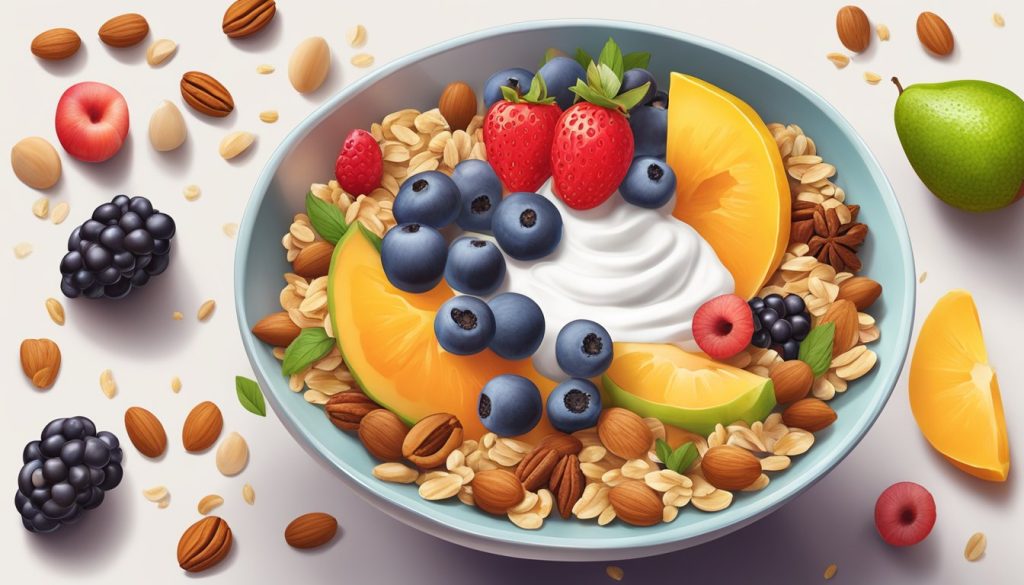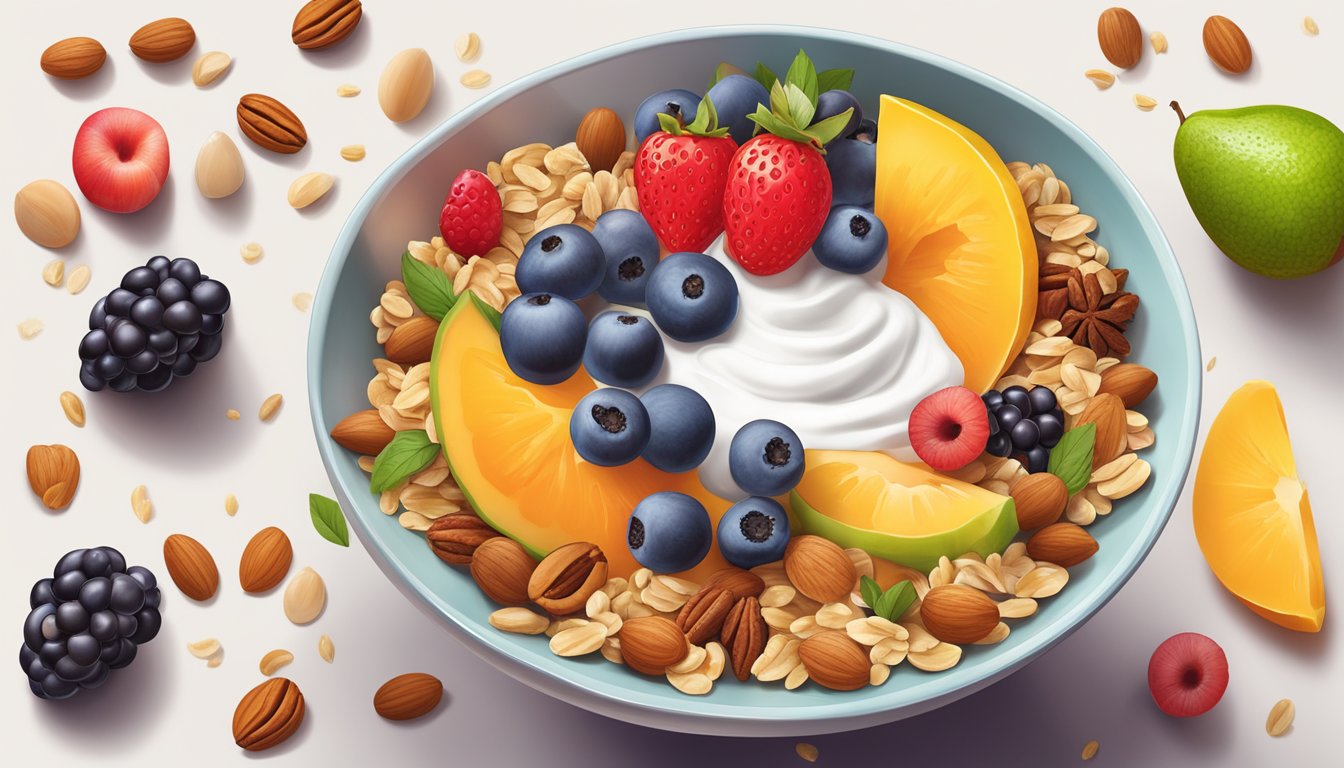Breakfast bowls have surged in popularity as a convenient and customizable morning meal option. Combining various ingredients like whole grains, fruits, vegetables, proteins, and healthy fats, these bowls offer a versatile way to start the day. When thoughtfully prepared, breakfast bowls can be a nutritious and balanced choice that provides sustained energy and essential nutrients.

The health value of a breakfast bowl largely depends on its components. Nutrient-dense ingredients like oats, quinoa, Greek yogurt, eggs, fresh fruits, and vegetables contribute to a well-rounded meal. These elements supply fiber, protein, vitamins, and minerals necessary for optimal bodily function. However, it’s important to be mindful of portion sizes and added sugars, which can quickly turn a healthy bowl into a calorie-dense meal.
By focusing on whole, unprocessed foods and limiting high-sugar toppings, breakfast bowls can support healthy eating goals. They allow for easy portion control and can be adapted to various dietary needs. Whether aiming for weight management, increased energy, or simply a satisfying start to the day, a properly constructed breakfast bowl offers a practical solution for busy individuals seeking a nutritious morning meal.
Exploring The Components of a Healthy Breakfast Bowl

A nutritious breakfast bowl combines key elements to fuel the body and mind for the day ahead. The right balance of protein, fiber, healthy fats, and vitamins creates a satisfying and energizing meal.
The Role of Protein in Satiety
Protein is essential for building and repairing tissues, and it plays a crucial role in keeping hunger at bay. Eggs, Greek yogurt, and lean meats are excellent protein sources for breakfast bowls.
Protein-rich options:
- Eggs (6g protein per large egg)
- Greek yogurt (15-20g protein per 6 oz serving)
- Lean meats (7g protein per oz of chicken)
These foods help stabilize blood sugar levels and promote a feeling of fullness. Adding protein to breakfast bowls can reduce snacking and overeating later in the day.
Plant-based proteins like tofu, tempeh, and legumes are also great choices. They offer similar satiety benefits while providing additional fiber and nutrients.
Importance of Fiber for Digestion
Fiber is crucial for maintaining a healthy digestive system and promoting regular bowel movements. Whole grains, fruits, and vegetables are excellent sources of fiber for breakfast bowls.
High-fiber ingredients:
- Oats (4g fiber per 1/2 cup)
- Berries (4g fiber per cup)
- Chia seeds (10g fiber per oz)
Fiber helps slow down digestion, leading to a more gradual release of energy throughout the morning. This can help prevent mid-morning energy crashes and hunger pangs.
Incorporating a mix of soluble and insoluble fiber supports gut health and can aid in maintaining a healthy weight. Aim for at least 5-10 grams of fiber in a breakfast bowl.
Incorporating Healthy Fats
Healthy fats are essential for hormone production, nutrient absorption, and brain function. They also contribute to the overall satiety of a breakfast bowl.
Good sources of healthy fats:
- Avocado
- Nuts and seeds
- Olive oil
These fats help the body absorb fat-soluble vitamins (A, D, E, and K) from other ingredients in the bowl. They also provide a creamy texture and rich flavor.
Omega-3 fatty acids, found in chia seeds, flaxseeds, and walnuts, offer additional anti-inflammatory benefits. Including a small portion of healthy fats can make breakfast bowls more satisfying and nutritionally complete.
Vitamins and Their Nutritional Benefits
Vitamins are essential micronutrients that support various bodily functions. A well-balanced breakfast bowl can provide a significant portion of daily vitamin needs.
Key vitamins in breakfast bowls:
- Vitamin C: Found in fruits like berries and citrus
- B vitamins: Present in whole grains and eggs
- Vitamin A: Abundant in leafy greens and colorful vegetables
These vitamins support immune function, energy metabolism, and skin health. Antioxidants in fruits and vegetables help protect cells from damage.
Vitamin D, often found in fortified dairy products or egg yolks, is crucial for bone health and immune function. Including a variety of colorful fruits and vegetables ensures a wide range of vitamins and minerals in the breakfast bowl.
Diverse Types of Breakfast Bowls
Breakfast bowls offer a wide variety of flavors, textures, and nutritional profiles to suit different tastes and dietary needs. From fruit-based options to savory creations, these versatile meals can be customized to provide a satisfying start to the day.
Smoothie and Acai Bowls: A Fruitful Start
Smoothie bowls blend frozen fruits with liquids to create a thick, creamy base. Popular ingredients include bananas, berries, and tropical fruits. Toppings like granola, nuts, and fresh fruit add crunch and extra nutrients.
Acai bowls feature the antioxidant-rich Amazonian berry. The frozen acai is blended into a sorbet-like consistency and topped with sliced fruits, seeds, and sometimes a drizzle of honey.
These bowls are often high in vitamins, minerals, and fiber. They can be a refreshing choice for warm mornings or post-workout fuel.
Savory Options: Beyond Traditional Cereal
Savory breakfast bowls offer a hearty alternative to sweet options. They typically include protein sources like eggs, meats, or plant-based alternatives.
Common ingredients:
- Eggs (scrambled, poached, or fried)
- Vegetables (spinach, tomatoes, avocado)
- Grains (quinoa, brown rice)
- Proteins (bacon, sausage, tofu)
These bowls can be customized to fit various dietary preferences, from vegetarian to low-carb. They often provide a balance of macronutrients to keep you full until lunch.
Granola and Yogurt: Crunchy and Creamy Delights
Granola and yogurt bowls combine contrasting textures for a satisfying meal. Greek yogurt is a popular base due to its high protein content and creamy consistency.
Granola adds crunch and can include:
- Oats
- Nuts
- Seeds
- Dried fruits
These bowls are easily customizable. Add fresh fruits for extra vitamins or a drizzle of honey for sweetness. Choose low-fat yogurt and limit granola portions to manage calorie intake.
Chia Pudding: A Textural Experience
Chia pudding offers a unique texture and nutritional profile. Chia seeds absorb liquid, creating a gel-like consistency when soaked overnight.
Key benefits:
- High in omega-3 fatty acids
- Rich in fiber
- Good source of protein
Chia puddings can be flavored with vanilla, cocoa, or fruit purees. Toppings like sliced almonds or fresh berries add variety. These bowls are often lower in calories than other options, making them suitable for those watching their intake.
Ingredient Spotlight

Breakfast bowls offer a versatile canvas for incorporating nutrient-dense ingredients. The right combination can boost energy levels, support overall health, and satisfy taste preferences.
Avocado and Eggs: A Nutrient-Packed Duo
Avocado and eggs form a powerhouse pairing in breakfast bowls. Avocados provide heart-healthy monounsaturated fats and fiber. They also contain potassium, which supports proper nerve function and blood pressure regulation.
Eggs offer high-quality protein and essential nutrients like vitamin D and choline. The combination of healthy fats and protein helps promote satiety, potentially reducing overall calorie intake throughout the day.
For a balanced bowl, pair sliced avocado with poached or scrambled eggs. This combination provides a creamy texture and rich flavor profile.
Integrating a Variety of Fruits
Fruits add natural sweetness, fiber, and vital nutrients to breakfast bowls. Berries, such as strawberries, blueberries, and raspberries, are excellent choices due to their high antioxidant content.
Sliced bananas offer potassium and natural sweetness. For a tropical twist, mango or pineapple chunks can be added. These fruits provide vitamin C and other essential nutrients.
Incorporating a mix of fruits ensures a diverse nutrient profile and keeps the bowl interesting. Aim for 1/2 to 1 cup of mixed fruits per serving.
The Benefit of Adding Veggies
Vegetables in breakfast bowls boost fiber intake and provide essential vitamins and minerals. Leafy greens like kale and baby spinach are nutrient-dense options rich in iron and vitamin K.
Sweet potatoes offer complex carbohydrates and beta-carotene. They can be roasted and cubed for a satisfying addition to the bowl.
Bell peppers and grape tomatoes add crunch and vitamin C. For a savory touch, sautéed mushrooms provide umami flavor and B vitamins.
A mix of raw and cooked vegetables ensures textural variety and maximizes nutrient absorption.
Unique Ingredients for a Gourmet Twist
Elevating breakfast bowls with unique ingredients can transform them into gourmet experiences. Black beans add plant-based protein and fiber, making the bowl more filling.
Red onions provide a sharp flavor and contain quercetin, an antioxidant with anti-inflammatory properties. Roasted garlic cloves offer a mellow, savory note and potential immune-boosting benefits.
For added crunch and healthy fats, sprinkle bowls with pumpkin seeds or sliced almonds. A dollop of Greek yogurt can introduce creaminess and additional protein.
Experiment with spices like turmeric or za’atar for international flair and potential health benefits.
Recipe Inspirations
Breakfast bowls offer endless possibilities for nutritious and delicious morning meals. From classic combinations to creative twists, there’s a bowl for every taste preference and dietary need.
Classic Breakfast Bowl Recipes
The quintessential breakfast bowl often features a hearty base of oatmeal or yogurt. A popular option is peanut butter banana oatmeal, combining creamy oats with sliced bananas and a dollop of protein-rich peanut butter. For a savory twist, egg breakfast bowls shine. These typically include scrambled or poached eggs atop a bed of roasted vegetables or whole grains.
Another classic is the acai bowl, blending frozen acai berries with other fruits and topping it with granola, fresh berries, and a drizzle of honey. Greek yogurt bowls offer a protein-packed start to the day, customizable with an array of toppings like nuts, seeds, and fresh fruit.
Creative Twists on Traditional Bowls
Innovative breakfast bowls put unique spins on familiar flavors. Quinoa breakfast bowls replace traditional oats with protein-rich quinoa, often mixed with almond milk and cinnamon. Sweet potato breakfast bowls use mashed sweet potatoes as a base, topped with almond butter, pecans, and a sprinkle of cinnamon.
Savory grain bowls incorporate ingredients like farro or barley, paired with sautéed greens, avocado, and a soft-boiled egg. For a Mediterranean-inspired option, try a bowl with hummus, cherry tomatoes, cucumber, and a sprinkle of za’atar seasoning.
Smoothie bowls offer a refreshing twist, blending frozen fruits with Greek yogurt or plant-based milk for a thick, spoonable consistency. Top with granola, chia seeds, and fresh fruit for added texture and nutrition.
Bowls for the Sweet Tooth
For those with a sweet tooth, breakfast bowls can still be a healthy choice. Caramelized banana oatmeal satisfies cravings with naturally sweet caramelized bananas atop warm oatmeal. Add a sprinkle of cinnamon and a drizzle of maple syrup for extra indulgence.
Chocolate lovers can enjoy cocoa-infused overnight oats, combining oats, cocoa powder, and milk of choice. Let it sit overnight and top with sliced strawberries and a handful of dark chocolate chips in the morning.
Apple pie breakfast bowls capture the essence of the classic dessert. Mix diced apples with cinnamon and a touch of maple syrup, then layer with Greek yogurt and top with granola for a crunchy finish.
Customizing Your Breakfast Bowl
Breakfast bowls offer endless opportunities for personalization. By selecting the right ingredients and combinations, you can create a nutritious and satisfying meal tailored to your tastes and dietary needs.
Building a Savory Breakfast Bowl
Start with a base of whole grains like quinoa or brown rice. Add protein such as eggs, bacon, or tofu for staying power.
Incorporate leafy greens like spinach or kale for vitamins and minerals. Roasted vegetables like sweet potatoes or bell peppers add flavor and nutrients.
For healthy fats, include avocado slices or a dollop of guacamole. Sprinkle with everything bagel seasoning for a flavor boost.
Top with a fried or poached egg for extra protein. Drizzle with hot sauce or add a spoonful of salsa for a kick of heat and acidity.
A Sweet Start: Customizable Fruit Bowls
Begin with a creamy base like Greek yogurt or smoothie. Layer with a variety of fresh fruits such as berries, banana slices, and diced mango.
Add crunch with a sprinkle of granola or chopped nuts. Include seeds like chia or flax for omega-3 fatty acids.
Sweeten naturally with a drizzle of honey or maple syrup. For added flavor, dust with cinnamon or cocoa powder.
Boost nutrition with a scoop of protein powder or collagen peptides. Finish with a splash of milk or plant-based alternative.
Condiments and Toppings
Enhance flavor and texture with a variety of toppings. Sprinkle with herbs like cilantro or basil for freshness.
Add crunch with toasted seeds or nuts. Drizzle with olive oil or tahini for healthy fats.
Boost umami with a dash of soy sauce or nutritional yeast. Incorporate fermented foods like kimchi or sauerkraut for probiotics.
Use hot sauce, sriracha, or chili oil for heat. Add a squeeze of lemon or lime juice for brightness.
Try different spice blends like za’atar or dukkah for unique flavors. Experiment with various nut butters for creaminess and protein.
Health Considerations in Breakfast Choices

Selecting a nutritious breakfast involves balancing several key factors. Careful attention to calorie content, sugar levels, and dietary restrictions can help ensure a healthy start to the day.
Caloric Balance and Weight Management
Breakfast bowls vary widely in calorie content. Pre-packaged options often contain 300-500 calories per serving. Homemade bowls allow for better portion control.
To manage weight, aim for a breakfast of 300-400 calories. Include protein and fiber to increase satiety. Greek yogurt, eggs, or lean meats are excellent protein sources.
Whole grains like oats or quinoa provide filling fiber. Be mindful of high-calorie toppings like nuts or dried fruit. Use them sparingly to avoid excess calories.
Managing Sugar Intake
Many breakfast bowls, especially fruit-based ones, can be high in sugar. Some commercial options contain up to 30 grams of sugar per serving.
Natural sugars from whole fruits are preferable to added sugars. Check labels for hidden sugars in granola, flavored yogurts, and sweetened plant-based milks.
Aim for less than 10 grams of added sugar per serving. Choose plain yogurt and sweeten with fresh berries. Cinnamon can add flavor without extra sugar.
Options for Dietary Restrictions
Gluten-free breakfast bowls are widely available. Use quinoa, buckwheat, or gluten-free oats as bases. Many brands offer certified gluten-free options.
For lactose intolerance, plant-based milks and yogurts work well. Almond, soy, or coconut milk provide creamy textures without dairy.
Vegan bowls can include chia seeds or tofu for protein. Nutritional yeast adds a cheesy flavor and B-vitamins.
Always read labels carefully to ensure products meet specific dietary needs.
The Convenience Factor of Breakfast Bowls
Breakfast bowls offer a practical solution for busy mornings, combining nutrition and ease. They save time and effort while providing a satisfying start to the day.
Quick and Easy Breakfast Solutions
Breakfast bowls provide a swift meal option for hectic mornings. Many varieties can be prepared in minutes, whether microwaved or assembled from pre-cooked ingredients. Cowboy breakfast bowls, for example, often feature eggs, potatoes, and meat that can be quickly reheated.
Pre-packaged bowls like those from Jimmy Dean offer grab-and-go convenience. These require minimal preparation, typically just a few minutes in the microwave.
For those who prefer homemade options, breakfast burrito bowls can be partially prepped the night before. Simply cook eggs in the morning and add to the prepared ingredients.
Meal Prep: Efficient Mornings
Meal prepping breakfast bowls streamlines the morning routine. Ingredients can be prepared in advance and stored in individual containers.
Popular components for meal prep include:
- Cooked grains (quinoa, oats, rice)
- Roasted vegetables
- Hard-boiled eggs
- Cooked meats (sausage, bacon)
- Chopped fruits
This approach allows for customization while saving time during busy weekdays. Assembling takes only moments, leaving more time for other morning activities.
Breakfast skillets can be prepped similarly, with ingredients ready to toss into a pan for a quick hot meal.
On-the-Go Breakfast Ideas
Breakfast bowls excel as portable meals for commuters and travelers. Many options are designed to be eaten cold or at room temperature.
Overnight oats serve as an ideal on-the-go breakfast. They can be prepared in jars for easy transport and consumed directly from the container.
For those preferring hot meals, insulated containers keep breakfast bowls warm for hours. This allows enjoyment of dishes like breakfast burrito bowls away from home.
Portable breakfast bowls often include a mix of protein, carbohydrates, and healthy fats to provide sustained energy throughout the morning.




